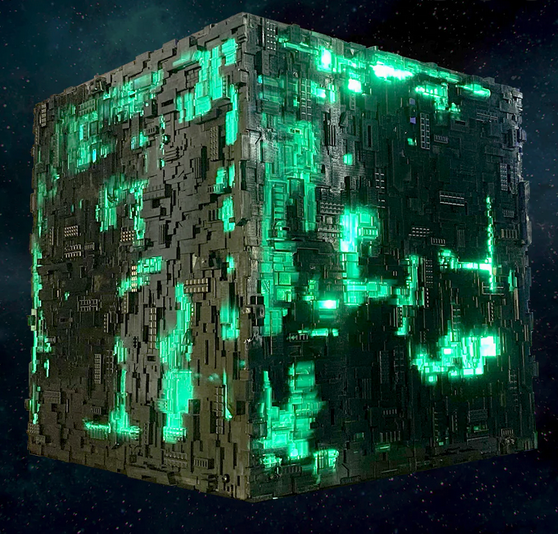Artifical Neural Network (Homebrew)¶
This ANN is mostly working, there is more write-up and then convert into a project statement.
the databases are too big for github
get copies from
http://54.243.252.9/engr-1330-psuedo-course/CECE-1330-PsuedoCourse/6-Projects/P-ImageClassification/
You need
mnist_train.csv and mnist_test.csv
import numpy # useful numerical routines
import scipy.special # special functions library
import scipy.misc # image processing code
#import imageio # deprecated as typical
import imageio.v2 as imageio
import matplotlib.pyplot # import plotting routines
# Get data files
import requests # Module to process http/https requests
import sys # Module to process commands to/from the OS using a shell-type syntax
remote_url="http://54.243.252.9/engr-1330-psuedo-course/CECE-1330-PsuedoCourse/6-Projects/P-ImageClassification/mnist_train.csv" # set the url
rget = requests.get(remote_url, allow_redirects=True) # get the remote resource, follow imbedded links
localfile = open('mnist_train.csv','wb') # open connection to a local file same name as remote
localfile.write(rget.content) # extract from the remote the contents,insert into the local file same name
localfile.close() # close connection to the local file
remote_url="http://54.243.252.9/engr-1330-psuedo-course/CECE-1330-PsuedoCourse/6-Projects/P-ImageClassification/mnist_test.csv" # set the url
rget = requests.get(remote_url, allow_redirects=True) # get the remote resource, follow imbedded links
localfile = open('mnist_test.csv','wb') # open connection to a local file same name as remote
localfile.write(rget.content) # extract from the remote the contents,insert into the local file same name
localfile.close() # close connection to the local file
remote_url="http://54.243.252.9/engr-1330-psuedo-course/CECE-1330-PsuedoCourse/6-Projects/P-ImageClassification/images.tar" # set the url
rget = requests.get(remote_url, allow_redirects=True) # get the remote resource, follow imbedded links
localfile = open('images.tar','wb') # open connection to a local file same name as remote
localfile.write(rget.content) # extract from the remote the contents,insert into the local file same name
localfile.close() # close connection to the local file
! tar -xvf images.tar # Extract some images
image_src/
image_src/tree.png
image_src/MyOne.png
image_src/tree784.png
image_src/cat.png
image_src/MyEight.png
image_src/pictures.png
image_src/MySix.png
image_src/MyZero.png
image_src/people.png
image_src/MyFive.png
image_src/MyThree.png
image_src/people784.png
image_src/MyFour.png
image_src/MySeven.png
image_src/.ipynb_checkpoints/
image_src/MyNine.png
image_src/MyTwo.png
image_src/cat784.png
class neuralNetwork: # Class Definitions
# initialize the neural network
def __init__(self, inputnodes, hiddennodes, outputnodes, learningrate):
# set number of nodes in input, hidden, and output layer
self.inodes = inputnodes
self.hnodes = hiddennodes
self.onodes = outputnodes
# learning rate
self.lr = learningrate
# initalize weight matrices
#
# link weight matrices, wih (input to hidden) and
# who (hidden to output)
# weights inside the arrays are w_i_j where link is from node i
# to node j in next layer
#
# w11 w21
# w12 w22 etc.
self.wih = (numpy.random.rand(self.hnodes, self.inodes) - 0.5)
self.who = (numpy.random.rand(self.onodes, self.hnodes) - 0.5)
# activation function
self.activation_function = lambda x:scipy.special.expit(x)
pass
# train the neural network
def train(self, inputs_list, targets_list):
# convert input list into 2D array
inputs = numpy.array(inputs_list, ndmin=2).T
# convert target list into 2D array
targets = numpy.array(targets_list, ndmin=2).T
# calculate signals into hidden layer
hidden_inputs = numpy.dot(self.wih, inputs)
# calculate signals from hidden layer
hidden_outputs = self.activation_function(hidden_inputs)
# calculate signals into output layer
final_inputs = numpy.dot(self.who, hidden_outputs)
# calculate signals from output layer
final_outputs = self.activation_function(final_inputs)
# calculate output errors (target - model)
output_errors = targets - final_outputs
# calculate hidden layer errors (split by weigths recombined in hidden layer)
hidden_errors = numpy.dot(self.who.T, output_errors)
# update the weights for the links from hidden to output layer
self.who += self.lr * numpy.dot((output_errors * final_outputs * (1.0 - final_outputs)), numpy.transpose(hidden_outputs))
# update the weights for the links from input to hidden layer
self.wih += self.lr * numpy.dot((hidden_errors * hidden_outputs * (1.0 - hidden_outputs)), numpy.transpose(inputs))
pass
# query the neural network
def query(self, inputs_list):
# convert input list into 2D array
inputs = numpy.array(inputs_list, ndmin=2).T
# calculate signals into hidden layer
hidden_inputs = numpy.dot(self.wih, inputs)
# calculate signals from hidden layer
hidden_outputs = self.activation_function(hidden_inputs)
# calculate signals into output layer
final_inputs = numpy.dot(self.who, hidden_outputs)
# calculate signals from output layer
final_outputs = self.activation_function(final_inputs)
return final_outputs
pass
print("neuralNetwork Class Loads OK")
neuralNetwork Class Loads OK
# Test case 1 p130 MYONN
# number of input, hidden, and output nodes
input_nodes = 784 # 28X28 Pixel Image
hidden_nodes = 110 # Should be smaller than input count (or kind of useless)
output_nodes = 10 # Classifications
learning_rate = 0.1 # set learning rate
n = neuralNetwork(input_nodes,hidden_nodes,output_nodes,learning_rate) # create an instance
print("Instance n Created")
Instance n Created
# load a training file
# replace code here with a URL get
## training_data_file = open("mnist_train_100.csv",'r') #connect the file#
training_data_file = open("mnist_train.csv",'r') #connect the file#
training_data_list = training_data_file.readlines() #read entire contents of file into object: data_list#
training_data_file.close() #disconnect the file#
# print(len(training_data_list)) ## activate for debugging otherwise leave disabled
# train the neural network
howManyTrainingTimes = 0
for times in range(0,1): # added outer loop for repeat training same data set
howManyTrainingRecords = 0
for record in training_data_list:
# split the values on the commas
all_values = record.split(',') # split datalist on commas - all records. Is thing going to work? #
inputs = (numpy.asfarray(all_values[1:])/255.0 * 0.99) + 0.01
# inputs = (numpy.asfarray(all_values[1:])/255.0 * 0.99) + 0.01
# print(inputs) ## activate for debugging otherwise leave disabled
# create target output values -- all 0.01 except for the label of 0.99
targets = numpy.zeros(output_nodes) + 0.01
# all_values[0] is the target for this record
targets[int(all_values[0])] = 0.99
n.train(inputs, targets)
howManyTrainingRecords += 1
pass
howManyTrainingTimes += 1
learning_rate *= 0.9
pass
print ("training records processed = ",howManyTrainingRecords)
print ("training episodes = ",howManyTrainingTimes)
# load a production file
## test_data_file = open("mnist_test_10.csv",'r') #connect the file#
test_data_file = open("mnist_test.csv",'r') #connect the file#
test_data_list = test_data_file.readlines() #read entire contents of file into object: data_list#
test_data_file.close() #disconnect the file#
training records processed = 60000
training episodes = 1
# test the neural network
scorecard = [] # empty array for keeping score
# run through the records in test_data_list
howManyTestRecords = 0
for record in test_data_list:
# split the values on the commas
all_values = record.split(',') # split datalist on commas - all records #
correct_label = int(all_values[0]) # correct answer is first element of all_values
# scale and shift the inputs
inputs = (numpy.asfarray(all_values[1:])/255.0 * 0.99) + 0.01
# query the neural network
outputs = n.query(inputs)
predict_label = numpy.argmax(outputs)
## print "predict =",predict_label,correct_label,"= correct" # activate for small test sets only!
if (predict_label == correct_label):
scorecard.append(1)
else:
scorecard.append(0)
pass
howManyTestRecords += 1
pass
print ("production records processed =", howManyTestRecords)
## print scorecard # activate for small test sets only!
# calculate performance score, fraction of correct answers
scorecard_array = numpy.asfarray(scorecard)
print ("performance = ",scorecard_array.sum()/scorecard_array.size)
production records processed = 10000
performance = 0.9475
# lets try one of my own pictures
# first read and render
#img_array = scipy.misc.imread("MyZero.png", flatten = True) Fuckers deprecated this utility!
img_array = imageio.imread("image_src/MyZero.png", as_gray = True)
img_data = 255.0 - img_array.reshape(784)
img_data = ((img_data/255.0)*0.99) + 0.01
matplotlib.pyplot.imshow(numpy.asfarray(img_data).reshape((28,28)),cmap = 'Greys') # construct a graphic object #
matplotlib.pyplot.show() # show the graphic object to a window #
matplotlib.pyplot.close('all')
mynumber = n.query(img_data)
mylabel = numpy.argmax(mynumber)
m0=img_data.mean() # gather some statistics
v0=img_data.var()
print ("my number = 0 ","my network thinks its = ",mylabel)

my number = 0 my network thinks its = 0
#first read and render
img_array = imageio.imread("image_src/MyOne.png", as_gray = True)
img_data = 255.0 - img_array.reshape(784)
img_data = ((img_data/255.0)*0.99) + 0.01
matplotlib.pyplot.imshow(numpy.asfarray(img_data).reshape((28,28)),cmap = 'Greys') # construct a graphic object #
matplotlib.pyplot.show() # show the graphic object to a window #
matplotlib.pyplot.close('all')
mynumber = n.query(img_data)
mylabel = numpy.argmax(mynumber)
m1=img_data.mean()
v1=img_data.var()
print ("my number = 1 ","my network thinks its = ",mylabel)

my number = 1 my network thinks its = 1
#first read and render
img_array = imageio.imread("image_src/MyTwo.png", as_gray = True)
img_data = 255.0 - img_array.reshape(784)
img_data = ((img_data/255.0)*0.99) + 0.01
matplotlib.pyplot.imshow(numpy.asfarray(img_data).reshape((28,28)),cmap = 'Greys') # construct a graphic object #
matplotlib.pyplot.show() # show the graphic object to a window #
matplotlib.pyplot.close('all')
mynumber = n.query(img_data)
mylabel = numpy.argmax(mynumber)
m2=img_data.mean()
v2=img_data.var()
print ("my number = 2 ","my network thinks its = ",mylabel)

my number = 2 my network thinks its = 2
#first read and render
img_array = imageio.imread("image_src/MyThree.png", as_gray = True)
img_data = 255.0 - img_array.reshape(784)
img_data = ((img_data/255.0)*0.99) + 0.01
matplotlib.pyplot.imshow(numpy.asfarray(img_data).reshape((28,28)),cmap = 'Greys') # construct a graphic object #
matplotlib.pyplot.show() # show the graphic object to a window #
matplotlib.pyplot.close('all')
mynumber = n.query(img_data)
mylabel = numpy.argmax(mynumber)
m3=img_data.mean()
v3=img_data.var()
print ("my number = 3 ","my network thinks its = ",mylabel)
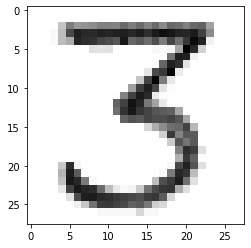
my number = 3 my network thinks its = 3
#first read and render
img_array = imageio.imread("image_src/MyFour.png", as_gray = True)
img_data = 255.0 - img_array.reshape(784)
img_data = ((img_data/255.0)*0.99) + 0.01
matplotlib.pyplot.imshow(numpy.asfarray(img_data).reshape((28,28)),cmap = 'Greys') # construct a graphic object #
matplotlib.pyplot.show() # show the graphic object to a window #
matplotlib.pyplot.close('all')
mynumber = n.query(img_data)
mylabel = numpy.argmax(mynumber)
m4=img_data.mean()
v4=img_data.var()
print ("my number = 4 ","my network thinks its = ",mylabel)
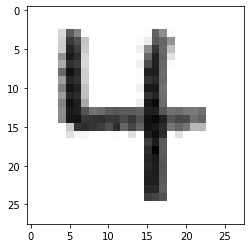
my number = 4 my network thinks its = 4
#first read and render
img_array = imageio.imread("image_src/MyFive.png", as_gray = True)
img_data = 255.0 - img_array.reshape(784)
img_data = ((img_data/255.0)*0.99) + 0.01
matplotlib.pyplot.imshow(numpy.asfarray(img_data).reshape((28,28)),cmap = 'Greys') # construct a graphic object #
matplotlib.pyplot.show() # show the graphic object to a window #
matplotlib.pyplot.close('all')
mynumber = n.query(img_data)
mylabel = numpy.argmax(mynumber)
m5=img_data.mean()
v5=img_data.var()
print ("my number = 5 ","my network thinks its = ",mylabel)

my number = 5 my network thinks its = 5
#first read and render
img_array = imageio.imread("image_src/MySix.png", as_gray = True)
img_data = 255.0 - img_array.reshape(784)
img_data = ((img_data/255.0)*0.99) + 0.01
matplotlib.pyplot.imshow(numpy.asfarray(img_data).reshape((28,28)),cmap = 'Greys') # construct a graphic object #
matplotlib.pyplot.show() # show the graphic object to a window #
matplotlib.pyplot.close('all')
mynumber = n.query(img_data)
mylabel = numpy.argmax(mynumber)
m6=img_data.mean()
v6=img_data.var()
print ("my number = 6 ","my network thinks its = ",mylabel)
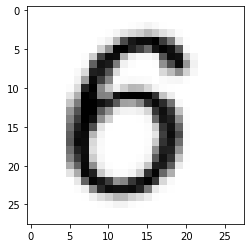
my number = 6 my network thinks its = 0
#first read and render
img_array = imageio.imread("image_src/MySeven.png", as_gray = True)
img_data = 255.0 - img_array.reshape(784)
img_data = ((img_data/255.0)*0.99) + 0.01
matplotlib.pyplot.imshow(numpy.asfarray(img_data).reshape((28,28)),cmap = 'Greys') # construct a graphic object #
matplotlib.pyplot.show() # show the graphic object to a window #
matplotlib.pyplot.close('all')
mynumber = n.query(img_data)
mylabel = numpy.argmax(mynumber)
m7=img_data.mean()
v7=img_data.var()
print ("my number = 7 ","my network thinks its = ",mylabel)
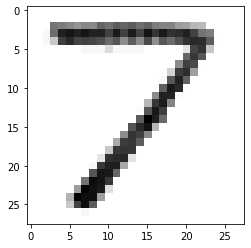
my number = 7 my network thinks its = 1
#first read and render
img_array = imageio.imread("image_src/MyEight.png", as_gray = True)
img_data = 255.0 - img_array.reshape(784)
img_data = ((img_data/255.0)*0.99) + 0.01
matplotlib.pyplot.imshow(numpy.asfarray(img_data).reshape((28,28)),cmap = 'Greys') # construct a graphic object #
matplotlib.pyplot.show() # show the graphic object to a window #
matplotlib.pyplot.close('all')
mynumber = n.query(img_data)
mylabel = numpy.argmax(mynumber)
m8=img_data.mean()
v8=img_data.var()
print ("my number = 8 ","my network thinks its = ",mylabel)

my number = 8 my network thinks its = 8
#first read and render
img_array = imageio.imread("image_src/MyNine.png", as_gray = True)
img_data = 255.0 - img_array.reshape(784)
img_data = ((img_data/255.0)*0.99) + 0.01
matplotlib.pyplot.imshow(numpy.asfarray(img_data).reshape((28,28)),cmap = 'Greys') # construct a graphic object #
matplotlib.pyplot.show() # show the graphic object to a window #
matplotlib.pyplot.close('all')
mynumber = n.query(img_data)
mylabel = numpy.argmax(mynumber)
m9=img_data.mean()
v9=img_data.var()
print ("my number = 9 ","my network thinks its = ",mylabel)
pass

my number = 9 my network thinks its = 9
print("my 0 statistics : ",m0,v0)
print("my 1 statistics : ",m1,v1)
print("my 2 statistics : ",m2,v2)
print("my 3 statistics : ",m3,v3)
print("my 4 statistics : ",m4,v4)
print("my 5 statistics : ",m5,v5)
print("my 6 statistics : ",m6,v6)
print("my 7 statistics : ",m7,v7)
print("my 8 statistics : ",m8,v8)
print("my 9 statistics : ",m9,v9)
my 0 statistics : 0.10840577 0.07128458
my 1 statistics : 0.0691415 0.045747854
my 2 statistics : 0.10085894 0.06906258
my 3 statistics : 0.15961523 0.071290515
my 4 statistics : 0.1313567 0.06362193
my 5 statistics : 0.11012904 0.07498277
my 6 statistics : 0.18414135 0.09940878
my 7 statistics : 0.11907936 0.056603365
my 8 statistics : 0.12214256 0.08051322
my 9 statistics : 0.123187415 0.07515885
References¶
Neural Network Digit Recognizer An online mimic using same dataset
LazyProgrammer. Unsupervised Machine Learning in Python: Master Data Science and Machine Learning with Cluster Analysis, Gaussian Mixture Models, and Principal Components Analysis . Kindle Edition.
Rashid, Tariq. Make Your Own Neural Network. Kindle Edition.
#first read and render
img_array = imageio.imread("image_src/cat784.png", as_gray = True)
img_data = 255.0 - img_array.reshape(784)
img_data = ((img_data/255.0)*0.99) + 0.01
matplotlib.pyplot.imshow(numpy.asfarray(img_data).reshape((28,28)),cmap = 'Greys') # construct a graphic object #
matplotlib.pyplot.show() # show the graphic object to a window #
matplotlib.pyplot.close('all')
mynumber = n.query(img_data)
mylabel = numpy.argmax(mynumber)
mX=img_data.mean()
vX=img_data.var()
print ("my number = cat784 ","my network thinks its = ",mylabel)

my number = cat784 my network thinks its = 8
print("my X statistics : ",mX,vX)
my X statistics : 0.60355407 0.023282547
